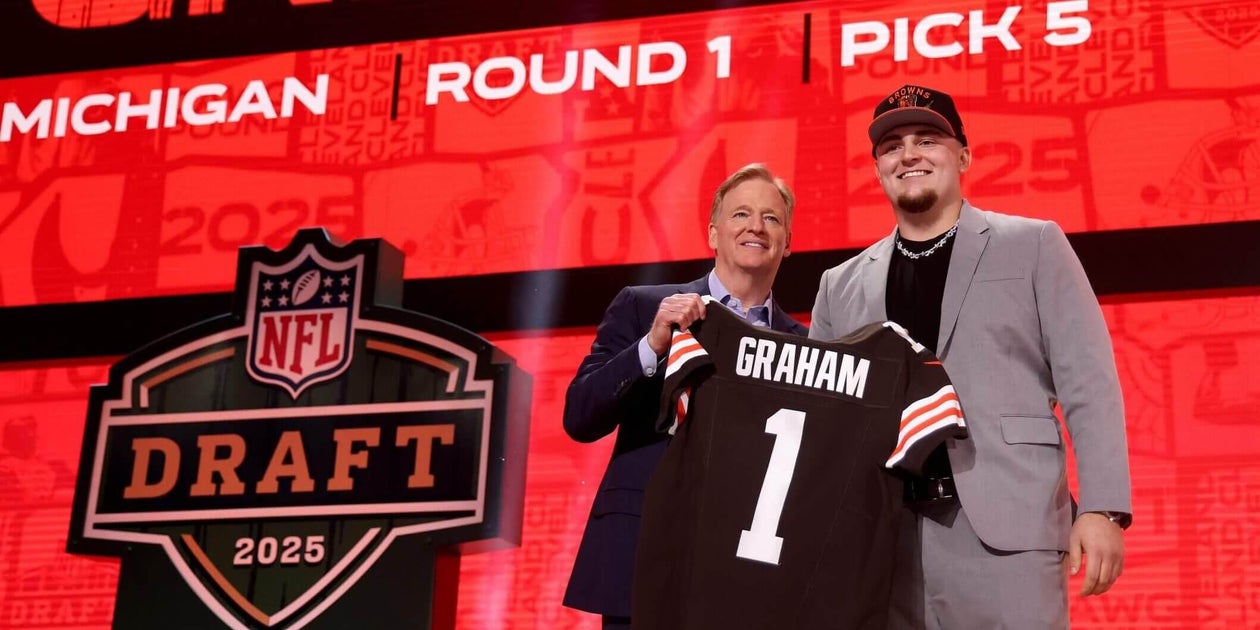

By now, you’ve surely seen plenty of NFL Draft grades, but the issue with many of them is that they are subjective, based on the grader’s pre-draft beliefs about the prospects, and don’t account for all of the variables in play.
Most are based purely on the players drafted and how they will fit into a team’s roster and scheme. And while those are certainly important pieces of the puzzle, there’s a lot more to consider.
Advertisement
For example, positional value isn’t talked about nearly enough in post-draft analysis. Rookie contracts are cheap, and if teams can find a star player at a premium position, they’ll be paying him far below market value for four to five years. That’s a huge deal when general managers are tasked with trying to build competitive rosters by maximizing every dollar they spend against the salary cap. On the flip side, if teams pick a star player at a non-premium position, while it’s great to have that star player, they lose out on the potential for adding surplus value.
Trades also seem to get lost in the shuffle of post-draft analysis, and they are a huge part of the value equation. Teams gain and lose a ton of value during the draft as they slide up and down the board.
So, our goal today is to put everything together (player value, positional value and trade value) before grading each NFL’s team performance in the draft.
You can read more about our process at the bottom, but here’s the brief synopsis:
First, we assigned a dollar value to each draft slot. Think about the rookie wage scale for each draft pick. For the 2025 class, the first pick has a total contract value of almost $49 million, while the 32nd pick has a value of just under $15 million. The 100th pick? About $6 million. And so on. Our trade analysis accounted for the value gained or added based on the picks traded.
The next step is grading the actual player picked, which we’ll do by comparing their draft slot to where he finished on our consensus big board. So, if a player is drafted higher than his consensus board placement, that’s considered a “reach” and a loss of value.
Finally, there is the positional adjustment. To calculate which positions hold the most value, we took the current top-10 salaries for the position determined by the NFL free agency market to quantify how each position is valued compared to the league average. For example, edge rushers have a top-10 average annual value of $27 million, whereas running backs come in at $12 million. This is the league telling us which positions it values most. We can apply that adjustment to each pick’s value. For example, an edge rusher drafted at No. 3 has considerably more value than a running back would have if picked in the same spot.
Advertisement
Lastly, before we get to the grades, remember this is a relative grading scale. Not all teams can be winners.
A more thorough explanation of our grading methodology can be found at the bottom of this story.
Winners
Cleveland Browns
The Browns made the biggest trade of the draft and came away from it huge winners, according to our formula. How big? The value added in that trade, which included securing an extra second-round pick and Jacksonville’s 2026 first-rounder, is equal to the 10th pick. Now, reaching for quarterback Dillon Gabriel in the third round while drafting Shedeur Sanders in the fifth round knocked down their value in terms of the actual players drafted. But the deal with Jacksonville, paired with drafting Mason Graham with the No. 5 pick, has Cleveland firmly in the top spot.
New York Giants
As mentioned above, owning more valuable picks is a sure-fire way to produce the best draft results, and the Giants didn’t disappoint. What’s interesting here is that they lost the equivalent of a fringe first-round pick by trading back into the first round for quarterback Jaxson Dart. He was a reach from a consensus standpoint, but similarly to Ward, the upside of drafting a potential QB1 is immense.
Tennessee Titans
Ward was technically a “reach” by our consensus board, but the value upside of drafting a quarterback with the No. 1 pick is tremendous. Outside of Ward, the Titans selected premium position players with four of their first six picks, and the two picks that weren’t at premium positions — safety Kevin Winston Jr. and tight end Gunnar Helm — were viewed as “steals” on the consensus board.
Carolina Panthers
The Panthers picked three of the first 77 players drafted, and they went after premium positions with all three. Furthermore, the Panthers almost exclusively took players who rated higher on the consensus board, gaining value at each spot.
Atlanta Falcons
The Falcons had a top-five draft? Really? I don’t necessarily agree with it, but I understand how we got there. So, our formula saw their controversial trade back into the first round for James Pearce Jr. as giving up the equivalent of a late first-rounder. That’s not great, but they managed to overcome it overall.
Advertisement
It starts with their selection of Jalon Walker, who plays a premium position and was drafted below consensus. Pearce also plays a premium position, so that helped the Falcons’ cause. Still, I can’t get over how “same-y” they appear to be, with each playing the same position and weighing less than 250 pounds. I have concerns about how those players will fit together into the same scheme outside of passing situations.
Losers
Detroit Lions
It’s fair to question whether I should doubt the Lions’ draft strategy after the run they’ve been on the past few years, but out of their seven picks, four were considered reaches by our consensus board, including all three in the top 70. They also lost quite a bit of value in the trade market, highlighted by their big move up for board for wide receiver Isaac TeSlaa. They lost the fourth-most value in trades during the draft, and the three teams below them either gained a first-rounder or had the chance to draft Travis Hunter. The players may wind up being good fits, but I still think this was bad process.
New Orleans Saints
Teams that avoid “reaches” on the consensus board put themselves in a much better position to succeed in the long term. The Saints reached on their first four picks, with two of those coming at non-premium positions, including ninth overall pick Kelvin Banks Jr, who we are grading as a guard even though New Orleans is going to try him at tackle first. If second-round quarterback Tyler Shough hits, however, we can ignore this. But the rest of the draft class’ potential brings down the positional upside of drafting a quarterback.
Jacksonville Jaguars
Well, if the Browns were the biggest winners, almost solely based on the return from their trade with the Jaguars, then it’s no surprise to see Jacksonville down here. Sure, Travis Hunter might be a unicorn, and maybe he blossoms into a generational player, but this is a steep price to pay for someone who’s never played an NFL snap, especially one who doesn’t play quarterback. The Jaguars tried to make up for it a bit, however, by making additional trades to recoup some draft capital.
Miami Dolphins
Miami only made two selections in the first 142 picks, so again, it isn’t shocking to see the Dolphins down here. And according to the consensus board, they reached for the players they took at Nos. 13 and 37. Now, I think the consensus was criminally low on Kenneth Grant, but the pick that doomed them was “reaching” for interior offensive lineman Jonah Savaiinaea with the 37th pick. Ideally, teams should stay away from reaching for players at non-premium positions.
Minnesota Vikings
The Vikings entered the draft with the fewest picks in the league — and ended up only making one top-100 pick — so it’s not shocking they ended up as a loser. Still, they didn’t make the most of the picks they did have. Their first three picks were all “reaches” by the consensus board, and their first-round selection wasn’t at a premium position, though at least it was for an interior offensive lineman, which was a big need.
Wait, why are they so high/low?
We added this category after seeing how high (or low) other graders were on these three teams.
Green Bay Packers
I might disagree slightly with the numbers here. The Packers benefited from drafting two wide receivers in the top 100 picks, including their first-round selection. And with so many wide receivers on the roster already, it’s fair to question how much value they’ll gain on the field. However, if a team isn’t satisfied with its current situation, it’s best to keep firing away at premium positions, and that’s what Green Bay did. All eight of the Packers’ picks were at premium positions, which is a big reason they rank so highly here.
Seattle Seahawks
There’s been plenty of love for Seattle’s draft, and while I don’t think it was bad, it wasn’t anything special, either. A lot of this grade depends on Nick Emmanwori’s impact on the defense. He’s a safety, but he can do a lot more, so that makes his positional adjustment a little tougher to gauge. Projections go both ways, so as much upside as there is, you have to wonder about how it looks if he doesn’t hit. Pair that pick with an interior offensive lineman in the first round, and the ceiling on this class is capped for Seattle.
Los Angeles Chargers
At first glance, the Chargers drafted five players at premium positions, which should have kept them out of the cellar. However, they paired two poor strategies together when it comes to securing long-term value in a draft. First, they picked a running back in the first round; second, they consistently “reached” for players versus the consensus. Yes, RB Omarion Hampton fits the Jim Harbaugh system, but what’s the long-term upside here? The board also saw wide receiver Tre Harris and defensive tackle Jamaree Caldwell as reaches within the top 100.
Methodology
The overall process can be understood in terms of dollars. Each player has a value that is transformed into dollars, and each team has a salary cap that constrains how much it can spend in a given year. Every pick has a contract attached to it, which means that each pick’s “cost” is independent of the player or position that is drafted. In other words, the first pick gets the same contract no matter who is selected.
Advertisement
Trades might be the simplest way to understand this. The first pick has a value close to $49 million, while the last pick has a value of under $2 million. If a team traded the first pick for the last pick, it’d lose about $47 million in value.
Now, let’s get to the players. Each one has a spot on the consensus board and can be assigned pick values in the same manner as the draft picks themselves. For example, if a team drafted the 262nd player on the consensus board with the first pick, it would lose about $47 million in value. And if it drafted the first player on the consensus board with the 262nd pick, it would gain $47 million in value.
Now, I do make some adjustments for players who fall from their consensus position. That is largely because NFL teams are really good at what they do, and they have more information (medical, character and GPS-tracking data) than the public/consensus board and can make better decisions during the draft. To account for this, I penalize players who “fall” in the draft because that means multiple teams are passing on them. However, if a player is taken above the consensus board, that player does not receive an adjustment to his ranking, as we only have evidence of one team having that player ranked above the consensus.
The last part is the position adjustment. As mentioned above, edge rushers are considered more valuable in the NFL market than running backs: The top running back makes around $20 million per year, whereas the top edge rusher makes about twice that. This process is applied to all positions and applied to the pick. For this method, though, the player picked is not factored into the equation.
These three values are then combined and adjusted to where the league average of value gained/lost is $0. It’s a relative grading scale, as not all teams can be winners in a specific draft.
(Photo of Roger Goodell and Mason Graham: Stacy Revere / Getty Images)
This news was originally published on this post .




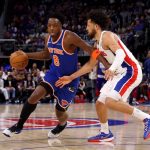
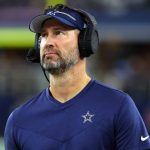

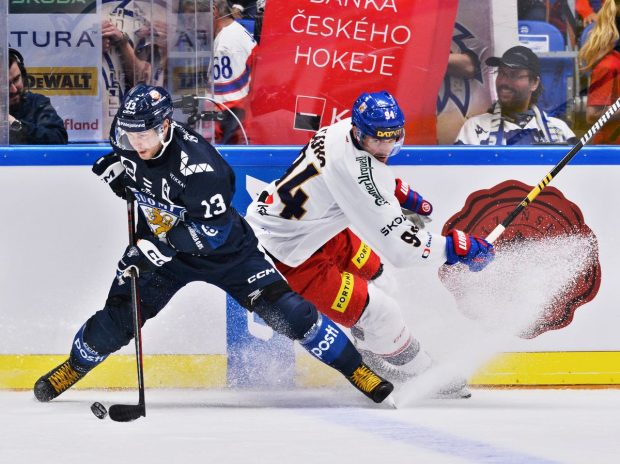

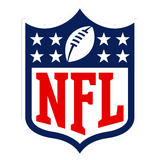
Be the first to leave a comment